The Story of Culture and Arts
- Image resource of Korean history
- Documents from History TextBooks
- Culture & Art Stories from Korean History
- Culture & Art Stories from Korean History - Korean
- National Institute of Korean History
- History net
- About the site
- Introduce
-
Numerous topics related to Korean culture and art are mentioned in middle and high school national history textbooks, but most of them are briefly described by era, making it difficult to understand their concepts, transition processes, and characteristics.
<Culture & Art Stories from Korean History> produces and provides video materials based on expert commentary on the flow, change process, characteristics and characteristics of each major topic in the field of culture and art in Korean history.

Scenario
Molten metal, the product of enduring a fire of 1200 degrees Celsius. And when poured into a mold at just the right moment, it is reborn into something in the shape of a bell.
“When something like molten metal exceeds 1200 degrees Celsius, it will of course prefer something hot to something cold. If there is moisture, it will start to bubble up. This is why there can be no water or moisture on a mold or rack.” Won Kwang-sik, Jucheoljang (metal casting master) / National Intangible Cultural Heritage No. 112
“Bells” - Where Scientific and Artistic Techniques Meet
By the hands of master craftsmen, we are able to carry on the beauty of this tradition. When most superior scientific knowledge available meets the purest art of our ancestors the result is an astounding collaboration - the bronze bell! Let's take a look at the intriguing history behind these bells.
A Completely Original and Korean Designed Bronze Bell
This is a dongjong, a bell with a majestic ring that can be heard for miles. Dongjong refers to bells that are made entirely of bronze. After the introduction of Buddhism to Korea, bells were used to alert the people of Buddhist ceremonies as well as to announce the time of day, special town gatherings, or the start of town festivities.
Throughout Asia, bells were developed at the same time Buddhist traditions were introduced, but the shape and characteristics of these bells differed by country.
If you compare the bells of China, Japan, and Korea, these differences become apparent.
Chinese bells are shaped like a tulip, their lower portion fanning slightly outward like petals. Japanese bells have the shape of an inverted cup and have remained largely unchanged for the past 1300 years.
The Korean bell has the characteristics of an upside-down pot, though the shape and production technique has changed with each generation.
The basic style of the Korean dongjong is considered to have been established in the Unified Silla Dynasty, and at this point in time, the original form of the Korean bell was complete.
Let's take a closer look at the structure of the Unified Silla dongjong.
The Yongnyu, or loop part of the bell, is sculpted in the shape of a dragon, while the eumgwan is shaped into a long tube for sound.
These features are unique to the Korean bell and help distinguish it from the bells of other countries, which do not have these parts.
The top and bottom portions of the Korean bell have their own band designs, termed the sangdae and hadae, respectively.
The upper part of the bell has four squares called yeongwak. Each was embellished with a scroll design along its parameter and had 9 protruding bud-shaped spheres, called yeolloe, which are inspired by the lotus flower.
At the center of the bell, we have the jongsinbujosang, a relief that sticks out ever so slightly from the bell, and the dangjwa, the spot where the bell is struck. Lastly, there is the myeongdong, or resonance pit, which is a complementary device separated from the bell and can only found in the bells of Korean Buddhist temples.
The Sangwonsa Dongjong is a masterpiece of the Unified Silla Dynasty and is the oldest dongjong in existence.
At the yongnyu, it seems as if the dragon is advancing with two paws in a sort of forceful stance. From the sangdae to the hadae, elaborately drawn patterning covers the bands.
Images of deities who have descended from the sky and are playing heavenly music are placed on the bell. All this is reason enough to call it the most magnificent dongjong in all of Korea.
The dongjong of the Goryeo Dynasty began to show differences in both form and decorations towards the end of that dynasty.
The ipsanghwamundae, or the floral-patterned band that stuck out somewhat, were added to the design, and the positions of the yongmeori (dragon's head) and the yeouiju (a wish-granting pearl) were changed.
Also, the number of dangjwa increased from two to four. These changes show the Goryeo Dynasty paid more attention to decoration.
During the Joseon dynasty, a new kind of dongjong was developed that combined aspects of the traditional Unified Silla design and the Chinese design.
There are now two dragon heads placed at the yongnyu and in many bell designs, the eumgwan and dangjwa have disappeared.
Those who knew about the majestic, deep sound and exceptional artistry of the Korean dongjong extended far and wide into neighboring countries.
There are now 53 confirmed Korean dongjong in Japan.
There have been numerous conjectures as to when these dongjong left the country. Whether taken during the Japanese Invasion of Korea in 1592, gifted to Japan by the Joseon kingdom, or taken during the period of Japanese colonial rule, all are perfectly plausible.
The reason there are so many Korean dongjong in Japan today has to do with their artistic value and exceptional sound, characteristics that cannot be found in any Japanese bell.
The Scientific Secrets of the Dongjong
While the exterior beauty of a dongjong is important, the depth and clarity of the sound it produces is equally important.
One reason for the exceptionalism of the Korean dongjong is right here.
The most classic example is the Divine Bell of King Seongdeok.
The largest bell in Korea is the Divine Bell of King Seongdeok, measuring 3.75 meters high, and weighing 18.9 tons, it is said to have required 120,000 geun (72,000kg) of bronze for its casting.
Silla’s King Gyeongdeok began production on the bell in order to honor his late father, King Seongdeok; but the bell was ultimately completed by Seongdeok’s grandson, King Hyegong. It took almost 34 years to complete.
The reason the Divine Bell of King Seongdeok is considered a masterpiece has to do with its sound.
The bell’s ringing and reverberation is said to resemble the sound of a heartbeat.
This is due to what they call "maengnoli phenomenon," or beating phenomenon.
Maengnoli means “to have a constant rhythm, like a heartbeat.”
Due to the maengnoli phenomenon, the sound of the Divine Bell of King Seongdeok lingers for a long time and has a much grander sound.
It is this phenomenon that distinguishes this bell as exceptional among all the bells of Korea.
The superior sound of Korean bells is all due to the way they are made.
The eumgwan rises above the copper figure of the dragon on the yongnyu. The eumgwan makes a bell’s sound much more delicate, while also serving a decorative urpose.
The ratio of copper and tin in the composition of a bell is also important. The amount of tin used determines the strength and sound of the bell—too much and it will break, too little and the sound quality decreases.
“The ratio of tin used should vary depending on the size of the bell. Is it cold or rainy? What’s the temperature now? Where should we pour into the mold? Should we pour from the top or from the bottom? Once you have perfected the ratio, the purity of the alloy is extremely important.” Won Kwang-sik, Jucheoljang (metal casting master) / National Intangible Cultural Heritage No. 112
Set just underneath the Divine Bell of King Seongdeok, which hangs close to the ground, is the myeongdong.
When the bell is rung, the sound vibrations hit the myeongdong and reflected off of it, magnifying the sound and extending the ring. You can find a similar technology in the speakers we use today.
This feature can only be found in Korean bells.
The physical beauty and moving sound of the Korean dongjong captivate one's eyes and ears.
Each dongjong is considered an unrivaled piece of art that perfectly integrates the religion, art, and science of its era.
[Epilogue]
Must-Know Facts on Culture and Art in Korean History
The creative shape of the Korean dongjong was formed during the Unified Silla period.
2. The Sangwonsa Temple Dongjong is the oldest dongjong still in existence in Korea.
3. The largest of all the ancient bells still in existence in Korea today is the
Divine Bell of King Seongdeok.
Fine Arts & Crafts
18 films-
 Earthenware08:28
Earthenware08:28 -
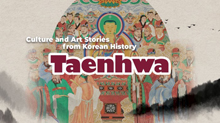 Taenghwa, or Buddhist Paintings in the Joseon Period08:36
Taenghwa, or Buddhist Paintings in the Joseon Period08:36 -
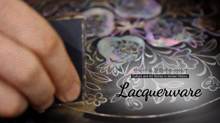 Lacquerware09:04
Lacquerware09:04 -
 Dyeing and Weaving08:21
Dyeing and Weaving08:21 -
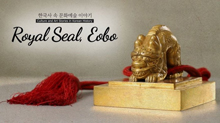 Royal Seal, Eobo07:53
Royal Seal, Eobo07:53 -
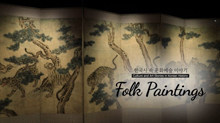 Folk paintings07:49
Folk paintings07:49 -
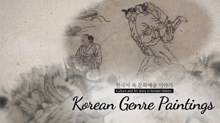 Korean Genre Paintings10:05
Korean Genre Paintings10:05 -
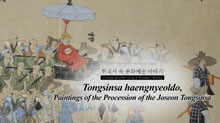 Paintings of the Procession of the Joseon Tongsinsa10:09
Paintings of the Procession of the Joseon Tongsinsa10:09 -
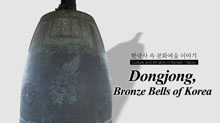 Dongjong, Bronze Bells of Korea08:50
Dongjong, Bronze Bells of Korea08:50 -
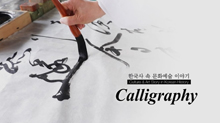 Calligraphy08:32
Calligraphy08:32 -
 White Porcelain08:18
White Porcelain08:18 -
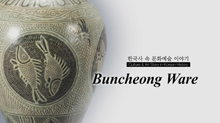 Buncheong Ware07:48
Buncheong Ware07:48 -
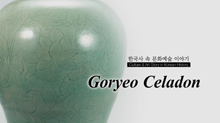 Goryeo Celadon07:54
Goryeo Celadon07:54 -
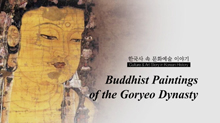 Buddhist Paintings of the Goryeo Dynasty07:57
Buddhist Paintings of the Goryeo Dynasty07:57 -
 Clay Figures, Figurines07:01
Clay Figures, Figurines07:01 -
 Clay Earthenware06:05
Clay Earthenware06:05 -
 Paintings of the Joseon Dynasty08:09
Paintings of the Joseon Dynasty08:09 -
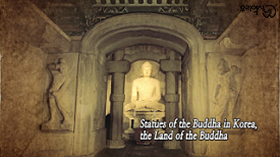 Statues of the Buddha in Korea09:03
Statues of the Buddha in Korea09:03

